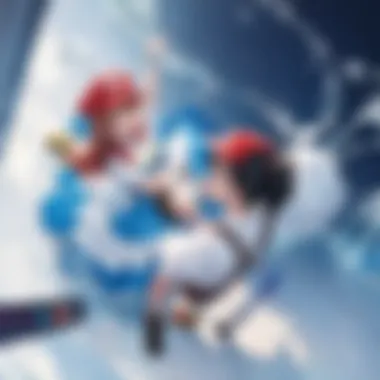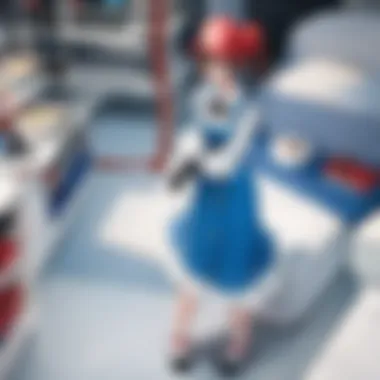Exploring the Hypothetical Super Mario on PlayStation 4


Intro
The exploration of merging Super Mario Brothers, an iconic Nintendo title, with the PlayStation 4 platform raises significant questions. The dynamics of this hypothetical crossover warrant a close examination of cultural, technical, and market factors that would influence such a move. The implications stretch beyond mere console compatibility. They encompass branding, gaming communities, and shifts in industry landscapes.
This article aims to dissect the layers surrounding this topic. Common inquiries like fan expectations and development challenges are pivotal. Readers will parse through details for an understanding of how the caliber of the Super Mario franchise aligns with perceptions of PlayStation's identity. Hence, a comprehensive investigation will apprehend these key thematic areas.
Cultural Context
Integrating Super Mario with PlayStation carries cultural weight. This transition would echo a blend of legacies. Super Mario is deeply rooted in Nintendo’s identity. Many gamers formed their childhoods around Mario's adventures. On the other side, PlayStation represents a distinct gaming culture, shaped by its signature titles and franchise experiences.
The crossover could symbolize integration versus alienation within the gaming horde. Both companies hold significant, yet divergent, consumer bases. Fans of Nintendo may take this shift poorly, feeling those nostalgic ties fray. In contrast, PlayStation loyalists may view it as an enrichment of their gaming experience.
Technical Considerations
To bring Super Mario Brothers to PS4, numerous technical difficulties surface. Nintendo's proprietary systems differ widely from Sony's architecture.
- Graphical Adaptation: Adapting the visuals which fans cherish into a different format requires meticulous care.
- Gameplay Mechanics: Ensuring that the fundamental gameplay resonates with both Mario and PlayStation’s gameplay styles is crucial.
Moreover, ensuring smooth performance while maintaining the allure of the franchise poses significant challenges. Both engineering and design teams must work collaboratively. Native developments must yield concepts charismatic enough to excite traditionalists.
Market Dynamics
Market considerations play an enriching role. This risky venture could incentivize or even alienate key demographics based solely on concerns over franchises trading platforms. The competitiveness of the gaming market signifies balancing risks with rewards. Quelling speculation about failure turns necessary. Opting for a title so iconic amplifies expectations.
Revitalizing Super Mario Brothers would require more than nostalgia. It mandates developers to innovate while honored memory tracks remain. Evaluating competing console strengths and loopholes provides a garment strategy, yet accepts harm to origins. Traditional players voice out; hence, creators espouse urgency given the biomarkers define failures as strongly as successes.
“A cross-platform approach could definitely attract broader audiences. Yet, capturing true fan engagement should be paramount.”
The End
As we dissect these facets, it becomes clearer. The interplay between Super Mario Brothers adapting for PlayStation 4 is not merely a mechanical process. It offers fertile ground for deeper contemplation on strategies, ideas of nostalgia, and the implications of ownership among gaming giants. In future sections, we will delve comprehensively into the challenges ahead, focusing on character dynamics and the essence of gameplay experiences nuanced to both platforms.
Readers are encouraged to consider these factors as we unfold various evaluation layers connected with this unique topic.
Intro to Super Mario Brothers
The introduction of Super Mario Brothers serves as a critical entry point into the discussions surrounding its hypothetical adaptation for PlayStation 4. This section underscores the game's significance within the vast landscape of video gaming culture. Understanding its development history, gameplay mechanics, and the cultural context it emerged from is vital. Players and industry observers alike will benefit from recognizing the unique aspects that define the Super Mario franchise.
Historical Context
The origins of Super Mario Brothers can be traced back to its release in 1985 by Nintendo. This platform game shattered records and set benchmarks in the gaming industry. Emerging from the creative mind of Shigeru Miyamoto, it not only popularized there genre but also helped to revitalize the video game market after the crash of 1983. The game's simple yet engaging design showcased innovative level design and character dynamics, paving the way for countless sequels and spin-offs over the decades.
Understanding the historical context adds depth to any analysis of a possible iteration on the PlayStation 4. Examining how Nintendo mastered the creation of game universes reveals lessons pertinent to modern game development. Super Mario Brothers didn't merely reinvent gaming but resided at the intersection of technology, culture, and creativity. Therefore, any considerations about upcoming iterations should place significant emphasis on this rich history supporting development decision making.
Cultural Significance
Cultural influence of Super Mario Brothers cannot be understated. The franchise transcended the gaming community and infiltrated mainstream culture. Iconic elements, including the character design of Mario and Luigi, the vibrant worlds, and memorable soundtracks became embedded in cultural consciousness. With references across various media, from movies to merchandise, the impact is pervasive.


Furthermore, Super Mario Brothers catalyzed a shift in how games are perceived globally. It initiated conversations about video game culture, its legitimacy as an art form, and its market potential. The nostalgia that continues to surround Mario's adventures speaks volumes about the game's emotional connection with fans.
In contemplating its adaptation for PlayStation 4, understanding the franchise's enduring popularity and fundamental cultural role is essential. Fans' expectations stretch beyond mere gameplay. They expect a sense of nostalgia interwoven with innovative elements familiar to them from prior experiences. Balancing these aspects is a major consideration for any developer aiming to revive this Italian plumber's iconic journey on a different console.
PlayStation Overview
The PlayStation 4, developed by Sony Interactive Entertainment, represents a significant milestone in gaming technology. Launched in November 2013, its impact on the gaming community cannot be understated. The discussion surrounding ‘Super Mario Brothers for PlayStation 4’ requires a thorough understanding of the console itself. The unique capabilities of the PlayStation 4 can inform the design and development considerations essential for porting such an iconic title.
Key elements to evaluate include its technical specifications and game library. These factors contribute heavily to how, if possible, a game designed primarily for one platform can be successfully adapted to another.
Technical Specifications
The technical specifications of the PlayStation 4 encompass various components vital for game performance, including the CPU, GPU, RAM, and storage capacity. The PlayStation 4 is powered by an AMD Jaguar 8-core processor. This architecture allows for smooth performance and complex computations necessary for games with rich interactive environments. With a graphics processing unit handling 1.84 teraflops, the console is adept at rendering high-quality graphics, a crucial aspect for modern games, crucial for translating the vivid worlds of Super Mario into this architecture.
Additionally, the console has 8 GB of GDDR5 RAM, enabling faster data transfer rates which improves load times and overall game fluidity. Certain features worth noting also include advanced social capabilities, gaming share options, and digital media appliance. These aspects can influence how well the platform can potentially carry out a classic title like Super Mario.
Game Library Analysis
The PlayStation 4 boasts an extensive library that caters to a diverse audience. Including genres from action-adventure such as The Last of Us Part II, to expansive RPG titles like Final Fantasy VII Remake, the breadth of gaming experiences available is unmatched. This variety displays the platform's potential to introduce gamers to not just one genre but several emotional and gameplays, strategies that can significantly differ from the traditional gameplay of the Mario franchise.
Looking at Super Mario Brothers in comparison to other franchises on this platform reveals both excitement and apprehension within the gaming community. Nostalgia is powerful, but so too is the need for innovation.
As shared on forums like reddit.com, enthusiasts speculate how adaptations might balance new gameplay mechanics against the essence of the original experience that fans hold dear.
Overall, the relevance of the PlayStation 4 lies not only in its present capacity to support new creations but also its undeniable influence on past games being reshaped for a new audience.
Franchise Crossovers in Gaming
Franchise crossovers have become increasingly significant in the gaming world, especially with established franchises like Super Mario Brothers. Such collaborations offer a rich blend of audiences and extended narratives. When we delve into the potential of Super Mario Brothers for PlayStation 4, we encounter both opportunities and challenges that influence the gaming landscape. These collabs can engage loyal fans while attracting new ones, ensuring that the core elements which define franchises are neither lost nor diluted.
Successful Cross-platform Examples
Several notable franchises have successfully made the leap across platforms, showcasing the potential for longevity and continued relevance. A few examples include:
- Fortnite: Originally designed for PC, it expanded to consoles seamlessly, drawing in players across nations.
- Minecraft: Its cross-platform play between devices such as Xbox, PlayStation, and even mobile devices highlights its inclusive strategy.
- Rocket League: The multiplayer dynamics allowed players from different consoles to enjoy the same gaming experience.
- Call of Duty: Warzone: With a unified player base, it set a precedent for robust connectivity and engaging sessions.
Each of these games has retained their core audience while also inviting new players, proving a successful crossover can flourish in commercial and participatory terms. For Super Mario Brothers on the PlayStation 4, it suggests a course where iconic characters and gameplay mechanics can entice a new audience providing they meet the expectations set by the originals.
Challenges of Cross-platform Releases
While successful cross-platform releases encourage attempts, many obstacles can emerge. Specific challenges include:
- Technical Challenges: Developers face hurdles in adapting existing titles to different console architectures. Each platform offers unique challenges with regard to graphics, performance, and user interface design.
- Brand Identity Confusion: Introducing Super Mario Brothers to PlayStation can obscure brand identities. Long-time Nintendo fans might question whether the experience remains authentic.
- Market Competition: There is a risk of alienating existing audiences. For instance, exclusive titles often generate strong community ties that could weaken after a franchise companies shift toward broader platforms.
- Licensing and Rights Issues: Developing agreements between companies can lead to complex negotiations, affecting timelines, budgets, and the final product.
Despite these challenges, many gamer’s anticipate innovation through crossover from established franchises. Not only does this embody the spirit of gaming evolution but can redirect perceptions about how franchises evolve in changing environments.
Fan Expectations for Super Mario Brothers on PS4


Understanding fan expectations for a potential Super Mario Brothers release on the PlayStation 4 is crucial in shaping the discussion around its cultural relevance and practical feasibility. Fans are not just consumers; they shape the dialogue surrounding gaming franchises. The specific desires, hopes, and concerns of dedicated gamers can influence development decisions profoundly. Analyzing these elements may reveal important guidance for both Nintendo and Sony when engaging with this fanbase in the context of a crossover title.
Community Insights
Community insights form a cornerstone of the gaming landscape. They sometimes guide conversations on platforms like Reddit and other social networks. Posting about Super Mario Brothers, fans discuss various aspects:
- Gameplay Mechanics: Members emphasize the need for familiar mechanics like power-ups and level design, preserving the series' core gameplay.
- Visual Style: Based on existing graphics of PS4, users expect enhanced environments without diminishing the charm of classic Mario aesthetics.
- Storyline Commitment: Players share their opinions on whether the beloved character should go on greater or less whimsical adventures.
The depth to which the community communicates shadows the strong bond that exists. Acknowledging these insights lets developers understand pivotal aspects to maintain brand loyalty while still exploring innovative avenues.
Feedback from Gaming Forums
Reviewing feedback from gaming forums paints a picture of varied sentiments within the player base. On platforms such as reddit.com, passionate discussions arise from fans talking about their expectations. The feedback tends to gravitate toward several themes:
- Innovation vs. Tradition: Many gamers express a keen interest in how new levels and challenges could harmonize with established mechanics, creating fresh experiences yet rooted in a sense of nostalgia.
- Accessibility: There are ongoing multinational conversations about UI design, with special focus on extending the game’s reach to a younger audience and newcomers to the platform.
- Monetization Concerns: Free-to-play models might deter traditional fans, who lean towards standalone experiences that do not compromise gaming quality for profits.
Technical Considerations for Porting
Understanding the technical considerations for porting an iconic game like Super Mario Brothers to the PlayStation 4 is essential. This process involves multiple elements that reflect both challenges and advantages. Game developers must account for the differences in hardware architecture, existing mechanics, and even player expectations. Porting a game is not merely about shifting code from one console to another; it requires an assessment of all technical aspects to ensure a seamless and enjoyable experience.
Adapting Game Mechanics
Adapting game mechanics is critical in transforming Super Mario Brothers for the PlayStation 4. Original gameplay functions well within the context of Nintendo’s platforms. For instance, the unique control scheme or response time on Nintendo systems may not transpose easily to the dual-shock controller seen in PS4. Changes to mechanics might involve adjusting the jumping timing or altering power-up functionalities.
This adaptation might also consider augmented features like online co-op abilities or enhancements that the PS4 platform offers compared to older systems. The feature of cloud saves on PlayStation can open avenues for game evolutions not possible in earlier Java-based systems.
Developers must work closely with testing teams to ensure these adaptations uphold gameplay integrity while also utilizing available new features of the PS4 for enriching player interaction and accessibility.
Graphics and Performance
Graphics and performance bring forth another layer of complexity. The visual capabilities of the PS4 surpass those of earlier consoles, allowing for richer texture and real-time environments. Developers could choose to upgrade Mario’s appearance into high-definition or implement enhancements to backgrounds and animations, thus catering to current gameplay standards.
Optimization for PS4’s hardware specifics is vital. For the best performance, texture sizes, frame rates, and loading times must be adjusted. Managers should be aware of the PS4’s RAM management policies too. Crucial decisions will include how to capture the essence of classic Mario without diluting the original aesthetics.
Additionally, stability is a concern; players should not encounter lag or graphics tearing. Graphics rendering practices must comply with PS4’s capabilities while aiming to achieve both aesthetic and performance goals.
Porting Super Mario Brothers to PS4 could modernize it, but staying true to the charm of the classic is paramount.
From understanding user-interface nuances to flexibility in performance optimization, the technical considerations form critical stepping stones toward a successful port.\nAfter overcoming these hurdles, there are fruitful prospects awaiting fans who hope to play an expanded version of this iconic title in a new arena.
Market Analysis and Competitive Landscape
Market analysis plays a crucial role in understanding how the gaming industry functions, especially for a title as significant as Super Mario Brothers. As we consider the implications of this franchise crossing over to the PlayStation 4, we look at the historical rivalry between Nintendo and Sony, as well as the market dynamics at play.
Nintendo vs.
PlayStation


The ongoing competition between Nintendo and PlayStation exemplifies various strategic business values, making it essential to examine.
- Brand Overview: Nintendo consistently positions itself with family-friendly content while Sony targets a broader range of age groups with its PlayStation lineup. This distinction can affect the Super Mario Brothers porting process.
- Market Shares: There is a significant market share standing, with Nintendo holding a unique user base and PlayStation boasting higher sales figures for some of its franchises. The shift of a such beloved title could potentially alter these percentages.
- Cultural Appeal: This one aspect allows the platforms to connect in varying degrees with users. Some fans harbor loyalty towards the Nintendo brand, further complicating cross-platform strategy.
In analyzing this, understanding how Super Mario Brothers fits into brands' ecosystems will be critical.
Potential Market Impact
The anticipated effects of Super Mario Brothers on the PlayStation 4's market provide another vital touchstone.
- Sales Projections: Potential sales spikes could come if the game were successfully ported. If analyzed, competitors might anticipate similar moves with their franchises, driving higher competition for exclusive opportunities.
- User Engagement: Introducing Mario to an existing PlayStation audience could lead to enhanced user factions. It could excite long-time fans and attract new audiences unfamiliar with the franchise.
- Revenue Streams: Super Mario Brothers holds an established brand with recognizable merchandise. Engaging this with PlayStation would unlock novel revenue avenues, maximizing partnerships opportunities and cross-promotion possibilities.
Such intended dynamics highlight vulnerabilities among established gaming titles and how amateur platforms can dramatically shift strategies. Filling unique gaps within the market landscape implies potential ventures may still find novelties among familiar frictions.
Por ting iconic titles allows companies to explore new audiences, and implications for audience capture resonate significantly with title lifetime
In these ways, recognizing the depth of these considerations enables identifying how market positioning of Super Mario Brothers on PlayStation 4 can create new developments, enhancing longevity and engagement not only for said franchise but across platforms contruing.
Implications for Nintendo and Sony
The hypothetical scenario of Super Mario Brothers for PlayStation 4 unfolds a fascinating dialogue between two major gaming powerhouses: Nintendo and Sony. This conversation illuminates potential shifts in brand identities, consumer expectations, and the broader gaming market.
Brand Loyalty and Identity
Brand loyalty plays a crucial role in the ever-evolving landscape of video games. Nintendo has established a steadfast fanbase that resonates with its distinct touch on gameplay, character development, and vibrant worlds. It is no longer just about games but a rich experience fostering nostalgia and familiarity. The introduction of Super Mario Brothers on a competitor's platform like the PlayStation 4 might be seen by many loyal Nintendo followers as a deviation from tradition. The allure of Mario on PlayStation could ignite discussions around Nintendo's core identity and ethos—an identity rooted in creative innovation and youthful imagination.
Current PlayStation users may perceive Nintendo titles, especially Super Mario, as distinct cultural products. For Sony, securing exclusive rights to a franchise as storied as Mario might attract gamers steered in by its mainstream auditing. However, existing PlayStation gamers must grapple with the legion of Nintendo enthusiasts, potentially sparking rivalry but stimulating conversation about multiverse of gaming. Despite these implications, both brands need to navigate this landscape tactfully to promote compatibility, coalescence, and fan acceptance.
Strategic Partnerships
The potential collaboration between Nintendo and Sony begs an examination of what strategic partnerships could lead to. Such arrangements can result in enriching game experiences and expanded audiences. The risks, however, arise from sourcing new creative techniques while adhering to brand-specific frameworks. Allowing Super Mario Brothers to exist on PS4 envelops possibilities alongside hurdles.
Sony’s hardware utilization and Nintendo’s game crafting expertise could pave the veg for an elaborate rendition of Mario. That could significantly enhance graphics while retaining classic mechanics synonymous with the franchise.
This collaboration can lead to alternate viewpoints on gaming mechanics that benefit not only the companies involved but also the gaming society holistically. Furthermore, it may promote discussions of cultural hybridization as fans expand their collective interests outside rigid console boundaries.
On the matter of brand perception and consumer habits, it is pivotal for both firms to not just endorse partnership but actively cultivate it to reap reciprocal benefits.
Ending
The conclusion of this article encapsulates the vast landscape of implications surrounding the hypothetical release of Super Mario Brothers for PlayStation 4. It focuses on several significant elements, such as potential market shifts, fan engagement dynanics, and cultural impacts that spread beyond mere entertainment. This section unravels how Super Mario, as part of a crossover meeting between Nintendo and PlayStation, evokes both excitement and apprehension from diverse gaming communities.
Summary of Findings
In our exploration, we discovered that Nintendo's flagship series, Super Mario, has a unique brand identity that shields fan expectations, often resulting in mixed reactions when discussed alongside any challenges of inter-console collaboration. We examined how the franchise has been perceived within the realm of PlayStation 4, finding speculations mostly centered around compatibility issues and transformative gameplay mechanics. Many fans interviewed highlighted the tension between innovation and nostalgia, expressing a desire for new experiences while preserving the feel of classic Mario gameplay. The analysis suggested a probable benefit for Sony's ecosystem, which stands to gain valuable market interest and audience boost. Conversely, it emphasized Nintendo’s drive to maintain brand integrity.
Future Considerations
Looking ahead, several factors may shape this potential crossover.
- Technological Advancements: As hardware continues to evolve, the compatibility and optimization for a game like Super Mario on PlayStation could become more feasible.
- Market Trends: Understanding shifting consumer preferences is essential. If cross-platform are receivers of positive commentary from both PlayStation and Nintendo communities, this could foster motivation.
- Strategic Collaborations: Future collaborations between titans of gaming could create promising avenues for diversity and innovation in gameplay.
As we conclude, the sunset across the horizon of gaming holds numerous possibilities. Engaging both avid gamers and industry observers ensures continued intrigue around the tangible transition of Super Mario Brothers into the playable realms of PS4.> "The potential for collaborative growth in gaming is ever-present, provided that innovative approaches emerge from these intersections."







